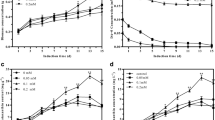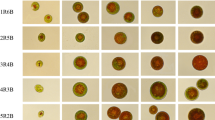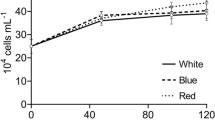Abstract
The optimum concentration of Na2WO4 was explored in relation to the cell density and astaxanthin content in Haematococcus pluvialis. Then, the cellular morphology, nitrate reductase (NR) activity, soluble sugar and protein contents, and chlorophyll fluorescence were measured, and the transcriptional expression of carotenogenic genes was determined by quantitative real-time PCR. The results showed that 3.0 mmol/L of Na2WO4 was the optimum concentration to induce astaxanthin accumulation, with a maximum content of 49.41±0.13 pg/cell reached on the tenth day. The NR activity decreased significantly and continually after Na2WO4 treatment. The soluble sugar content increased gradually during the experimental period and was eventually significantly higher than that in the control. The soluble protein content increased rapidly, reached a maximum in day 0.5 and day 1 and then decreased. The effective photochemical efficiency of PSII ( Fv'/Fm') and light saturation ( Ek) first decreased and then tended to stabilize, and NADP+-glyceraldehyde-3-phosphate dehydrogenase (GAPDH) gene expression was correlated with photosynthesis. The transcriptional expression of ipi, psy and bkt was significantly increased compared with that in the control after application of Na2WO4, and the relative expression of ipi reached the highest level on the fifth day, with a 98.03±1.92-fold increase. Our results describe a new approach to promote the effective accumulation of astaxanthin in H. pluvialis by NR inhibitor Na2WO4.
Similar content being viewed by others
References
Algae Industry Magazine. 2017. Advanced technologies driving astaxanthin market. http://www. algaeindustrymagazine.com/report–suggests–astaxanthinmarket–2–57–billion–2025/. Accessed on 2017–08–6.
Ambati R R, Phang S M, Ravi S & Aswathanarayana R G. 2014. Astaxanthin: sources, extraction, stability, biological activities and its commercial applications–a review. Marine Drugs, 12 (1): 128–152.
Ambati R R, Sindhuja H N, Dharmesh S M, Sankar K U, Sarada R, Ravishankar G A. 2013. Effective inhibition of skin cancer, tyrosinase, and antioxidative properties by astaxanthin and astaxanthin esters from the green alga Haematococcus pluvialis. Journal of Agricultural and Food Chemistry, 61 (16): 3 842–3 851.
Barbosa M J, Morais R, Choubert G. 1999. Effect of carotenoid source and dietary lipid content on blood astaxanthin concentration in rainbow trout ( Oncorhynchus mykiss ). Aquaculture, 176 (3–4): 331–341.
Boussiba S, Fan L, Vonshak A. 1992. Enhancement and determination of astaxanthin accumulation in green alga Haematococcus pluvialis. Methods in Enzymology, 213: 386–391.
Boussiba S, Vonshak A. 1991. Astaxanthin accumulation in the green alga Haematococcus pluvialis. Plant and Cell Physiology, 32 (7): 1 077–1 082.
Boussiba S. 2000. Carotenogenesis in the green alga Haematococcus pluvialis: cellular physiology and stress response. Physiologia Plantarum, 108 (2): 111–117.
Chen S X, Liang Y, Wang H. 2012. Effects of different nitrogen and phosphorus concentrations on the chlorophyll fluorescence parameters of Haematococcus pluvialis. Freshwater Fisheries, 42 (1): 15–19. (in Chinese with English abstract)
Disch A, Schwender J, Müller C, Lichtenthaler H K, Rohmer M. 1998. Distribution of the mevalonate and glyceraldehyde phosphate/pyruvate pathways for isoprenoid biosynthesis in unicellular algae and the cyanobacterium Synechocystis PCC 6714. Biochemical Journal, 333 (2): 381–388.
Domínguez J E, Muñoz M C, Zafra D. 2003. The antidiabetic agent sodium tungstate activates glycogen synthesis through an insulin receptor–independent pathway. Journal of Biological Chemistry, 278 (44): 42 785–42 794.
Dong Q L, Zhao X M, Xing X Y, Gong J X, HU J Z. 2006. Biosynthesis of astaxanthin in Haematococcus pluvialis caused by suppression on nitrogen and carbon metabolisms. Chemical Engineering ( China ), 34 (12): 48–49, 57. (in Chinese with English abstract)
Eilers P H C, Peeters J C H. 1988. A model for the relationship between light intensity and the rate of photosynthesis in phytoplankton. Ecological Modelling, 42 (3–4): 199–215.
Fábregas J, Domínguez A, Álvarez D G, Lamela T, Otero A. 1998. Induction of astaxanthin accumulation by nitrogen and magnesium deficiencies in Haematococcus pluvialis. Biotechnology Letters, 20 (6): 623–626.
Fan L M. 2012. Preliminary Study on the Breeding of High–Lipid Content Marine Golden Algae. Ocean University of China, Qingdao, China. (in Chinese with English abstract)
Gao Z Q, Meng C X, Gao H Z, Zhang X W, Xu D, Su Y F, Wang Y Y, Zhao Y R, Ye N H. 2013. Analysis of mRNA expression profiles of carotenogenesis and astaxanthin production of Haematococcus pluvialis under exogenous 2, 4–epibrassinolide (EBR). Biological Research, 46 (2): 201–206.
Gao Z Q, Meng C X, Zhang X W, Xu D, Zhao Y F, Wang Y T, Lv H X, Yang L M, Chen L Q, Ye N H. 2012. Differential expression of carotenogenic genes, associated changes on astaxanthin production and photosynthesis features induced by JA in H. pluvialis. PLoS One, 7 (8): e42243.
Gwak Y, Hwang Y S, Wang B B, Kim M, Jeong J, Lee C G, Hu Q, Han D X, Jin E. 2014. Comparative analyses of lipidomes and transcriptomes reveal a concerted action of multiple defensive systems against photooxidative stress in Haematococcus pluvialis. Journal of Experimental Botany, 65 (15): 4 317–4 334.
Han D X, Li Y T, Hu Q. 2013. Astaxanthin in microalgae: pathways, functions and biotechnological implications. A lgae, 28 (2): 131–147.
Huang J C, Chen F, Sandmann G. 2006. Stress–related differential expression of multiple β–carotene ketolase genes in the unicellular green alga Haematococcus pluvialis. Journal of Biotechnology, 122 (2): 176–185.
Kim D K, Hong S J, Bae J H, Yim N, Jin E, Lee C G. 2011. Transcriptomic analysis of Haematococcus lacustris during astaxanthin accumulation under high irradiance and nutrient starvation. Biotechnology and Bioprocess Engineering, 16: 698–705.
Kobayashi M, Kakizono T, Nishio N, Nagai S, Kurimura Y, Tsuji Y. 1997. Antioxidant role of astaxanthin in the green alga Haematococcus pluvialis. Applied Microbiology and Biotechnology, 48 (3): 351–356.
Lee Y K, Ding S Y. 1994. Cell cycle and accumulation of astaxanthin in Haematococcus lacustris (Chlorophyta). Journal of Phycology, 30 (3): 445–449.
Li H S. 2000. Principles and Techniques of Plant Physiological Biochemical Experiment. Higher Education Press, Beijing, China. (in Chinese)
Li Y T, Sommerfeld M, Chen F, Hu Q. 2008. Consumption of oxygen by astaxanthin biosynthesis: a protective mechanism against oxidative stress in Haematococcus pluvialis (Chlorophyceae). Journal of Plant Physiology, 165 (17): 1 783–1 797.
Li Y T, Sommerfeld M, Chen F, Hu Q. 2010. Effect of photon flux densities on regulation of carotenogenesis and cell viability of Haematococcus pluvialis (Chlorophyceae). Journal of Applied Phycology, 22 (3): 253–263.
Li Y T. 2007. The role of carotenogenesis in the response of the green alga Haematococcus Pluvialis to oxidative stress. The University of Hong Kong, Hong Kong, China.
Liang C W, Zhao F Q, Qin S, Tan C P, Wei W, Meng C X. 2006. Molecular cloning and characterization of phytoene synthase gene from a unicellular green alga Haematococcus pluvialis. Progress in Biochemistry and Biophysics, 33 (9): 854–860.
Liang L, Chen J, Su X J, Xu H, Yuan X H, Chen J F. 2008. Effects of nitrate reductase activity in root on absorption and metabolism of nitrate in Brassica campestris L. ssp. Chinesis Makino. Jiangsu Agricultural Sciences, 36 (3): 153–155. (in Chinese with English abstract)
Livak K J, Schmittgen T D. 2001. Analysis of relative gene expression data using real–time quantitative PCR and the 2–ΔΔ C t method. Method s, 25 (4): 402–408.
Lv H X, Xia F, Liu M, Cui X G, Wahid F, Jia S R. 2016. Metabolomic profiling of the astaxanthin accumulation process induced by high light in Haematococcus pluvialis. Algal Research, 20: 35–43.
Pashkow F J, Watumull D G, Campbell C L. 2008. Astaxanthin: a novel potential treatment for oxidative stress and inflammation in cardiovascular disease. American Journal of Cardiology, 101 (10): S58–S68.
Pelah D, Marton I, Wang W, Shoseyov O, Altman A, Cohen E. 2004. Accumulation and protection activity of proteaseresistant heat–stable proteins in Haematococcus pluvialis during high light and nitrogen starvation. Journal of Applied Phycology, 16 (2): 153–156.
Ralph P J, Gademann R. 2005. Rapid light curves: a powerful toolto assess photosynthetic activity. Aquatic Botany, 82 (3): 222–237.
Ranga R, Sarada A R, Baskaran V, Ravishankar G A. 2009. Identification of carotenoids from green alga Haematococcus pluvialis by HPLC and LC–MS (APCI) and their antioxidant properties. Journal of Microbiology and Biotechnology, 19 (11): 1 333–1 341.
Raven P H, Evert R F, Eichhorn S E. 2005. Biology of Plants. 7th ed. W. H. Freeman and Company, New York, USA.
Shen X, Jiao Y Y, Zhu B H, Yang P G, Pan K H. 2011. Effect of nitrogen deficiency and sodium tungstate in medium on the fatty acid composition of Nannochloropsis oculata. Transactions of Oceanology and Limnology, (4): 78–82. (in Chinese with English abstract)
Su Y X, Wang J X, Shi M L, Niu X F, Yu X H, Gao L J, Zhang X Q, Chen L, Zhang W W. 2014. Metabolomic and network analysis of astaxanthin–producing Haematococcus pluvialis under various stress conditions. Bioresource Technology, 170: 522–529.
Tian H, Duan M Y, Wang L. 2009. Research progress on nitrate reductase functions in plants. Chinese Agricultural Science Bulletin, 25 (10): 96–99. (in Chinese with English abstract)
Vidhyavathi R, Venkatachalam L, Sarada R, Ravishankar G A. 2008. Regulation of carotenoid biosynthetic genes expression and carotenoid accumulation in the green alga Haematococcus pluvialis under nutrient stress conditions. Journal of Experimental Botany, 59 (6): 1 409–1 418.
Wang J J, Tang Z H. 2014. The regulation of soluble sugars in the growth and development of plants. Botanical Research, 3 (3): 71–76. (in Chinese with English abstract)
Wang J Y, Zhou C X, Yan X J, Luo Q J, Jiang Y, Ma B, Tan Y H. 2014. The characteristics of growth and nutrient consumption of Haematococcus pluvialis under red light. Acta Hydrobiologica Sinica, 38 (6): 1 135–1 142. (in Chinese with English abstract)
White S, Anandraj A, Bux F. 2011. PAM fluorometry as a toolto assess microalgal nutrient stress and monitor cellular neutral lipids. Bioresource Technology, 102 (2): 1 675–1 682.
Wouters J, Oudjama Y, Ghosh S, Stalon V, Droogmans L, Oldfield E. 2003. Structure and mechanism of action of isopentenylpyrophosphate–dimethylallylpyrophosphate isomerase. Journal of the American Chemical Society, 125 (11): 3 198–3 199.
Xu L Z, Cai J, Jiang Z M, Peng X B, Su X F, Zhang S X. 2008. Effects of water stress on osmotic adjustment and activity of protect enzymes in the leaves of three sorts of seedlings. Journal of Northwest Forestry University, 23 (2): 12–16. (in Chinese with English abstract)
Yamashita E. 2013. Astaxanthin as a medical food. Functional Foods in Health and Disease, 3 (7): 254–258.
Yang R, Qiu W H, Wang Z H, Wang X Y. 2012. Effects of nitrate reductase inhibitor Na2WO4 on nitrate accumulation in oilseed rape. Plant Physiology Journal, 48 (1): 51–56. (in Chinese with English abstract)
Yu M, Hu C X, Sun X C, Wang Y H. 2010. Influences of Mo on nitrate reductase, glutamine synthetase and nitrogen accumulation and utilization in Mo–efficient and Moinefficient winter wheat cultivars. Agricultural Sciences in China, 9 (3): 355–361.
Zhao T, Chen Y, Xie H, Liang J S. 2004. The research progress of the regulation of nitrate reductase activity and the possible mechanism. Guihaia, 24 (4): 367–372. (in Chinese with English abstract)
Author information
Authors and Affiliations
Corresponding author
Additional information
Supported by the National Natural Science Foundation of China (No. 31572638), the Public Benefit Program of Zhejiang Science and Technology Department (No. 2015C32021), the Program of Ningbo Science and Technology Bureau (No. 2014C10023), the NSF of Ningbo Government (No. 2015A610265), the Project of Science and Technology Innovation for College Students in Zhejiang Province (No. 2016R405078), the K. C. Wong Magna Fund in Ningbo University, and the Subject Project of Ningbo University (No. xkl1526)
Rights and permissions
About this article
Cite this article
Li, Y., Cui, D., Zhuo, P. et al. A new approach to promote astaxanthin accumulation via Na2WO4 in Haematococcus pluvialis. J. Ocean. Limnol. 37, 176–185 (2019). https://doi.org/10.1007/s00343-018-7317-0
Received:
Accepted:
Published:
Issue Date:
DOI: https://doi.org/10.1007/s00343-018-7317-0




